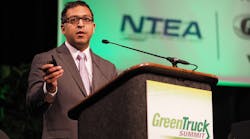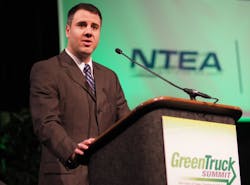INDIANAPOLIS. If the U.S. Dept. of Energy (DOE) has anything to say about it, Class 8 trucks that haul freight twice as efficiently in real-world conditions burning conventional fuels — and do this with affordable technology — could be reality someday soon.
Reuben Sarkar, DOE's deputy assistant secretary for transportation, announced Tuesday at the start of NTEA's Green Truck Summit that the department plans to invest $80 million in SuperTruck II, building upon the 2010 SuperTruck initiative. "SuperTruck was aimed at developing Class 8 tractor-trailers that have 50% higher freight efficiency than baseline models by the year 2015, with a percentage of this coming from engine efficiency gains," he told attendees.
In that earlier program, four teams — Cummins-Peterbilt, Daimler Trucks North America, Volvo and Navistar — embarked on efforts to reach that goal compared with 2009 Class 8 models partly supported by DOE funds. The Cummins-Peterbilt team achieved a 70% freight efficiency gain on a ton-mile-per-gallon basis, and the Daimler team managed more than twice the goal with a 115% gain. The Volvo and Navistar teams are on track to exceed the 50% mark as well, Sarkar said.
"We're seeing tremendous amounts of increases that are coming from these demonstration and research programs," he noted, adding that the four teams used technologies including aerodynamics packages, low rolling resistance tires, engine and waste heat recovery, and highly efficient combustion engines.
"All of these together comprise kind of a key set of technologies that were able to double fuel economy in some cases, going all the way up to 12 mpg" in real-world driving conditions, Sarkar contended. Some 22-44% of the efficiency gains came from increased engine efficiency, he said, and the earlier initiative identified "a number of additional opportunities for commercial truck efficiency improvements."
DOE's SuperTruck II program not only raises the bar for a 100% freight efficiency gain vs. that of 2009 Class 8 trucks, it emphasizes that the improvement be attainable through affordable technologies. Participants will be able to propose additional applications beyond the first project's long-haul focus, Sarkar noted, such as regional-haul trucking. SuperTruck II trucks will need to meet performance, safety and emissions standards as well.
"As the backbone of domestic freight transportation, 18-wheeler long-haul trucks carry 70% of all freight tonnage. So we find this the most ample place to focus our efforts," he said. "Our goal is that the technologies in SuperTruck II will continue to push the boundaries and pay particular close attention to what's cost-effective in the marketplace. So it'll require innovation just to get the cost out of some of these technologies."
Burning world
This latest initiative is part of DOE's efforts to help foster a clean energy economy and combat global warming, according to Sarkar. To do that, the department has its sights set on very significant greenhouse gas emissions reductions in the face of a "ballooning" world population projected to grow another third by 2050 — and with all those new humans driving up the thirst for, and expenditure of, energy.
"Our top scientists are telling us we need to be reducing greenhouse gas emissions by up to 80% by 2050 to avoid the most devastating impacts of climate change," Sarkar said. And because of the time required for new technologies to reach the market, he said investments like those planned under the SuperTruck II program need to happen now.
However, there's a real threat to the drive to reach more efficient freight transportation, Sarkar and other speakers at the Green Truck Summit pointed out: stagnation in innovation due to "bargain-basement" prices of oil and derivative gasoline and diesel fuels. Thus more investments in technology gains are needed precisely when it's more challenging for fleets to make the business case for them.
Long run
Even so, speakers at the opening session repeatedly made the point that oil prices aren't likely to stay at their present levels of $30-33 a barrel for long, suggesting that continued investment in alternative fuels is a goal for fleets planning for the long term.
"We're going to focus on how to weather this blip — or should we say, 'sag' — in traditional petroleum prices while preparing for the next spike in oil prices, which if history is any guide, could come suddenly, and perhaps violently," said John Davis, creator and executive producer of MotorWeek.
Bob Carrick, natural gas sales manager at Freightliner, put it this way: "Control your fuel, and you will control your destiny. Remember that phrase, because it's going to be around for the next 50 years." He noted that bottom-line gains are still possible for fleets by investing in alternative fuels and "green" technologies.
"It's a tough thing, because the financial benefits we've all enjoyed over the last few years with these [environmentally sustainable] strategies have been reduced. They're not completely gone — there are still financial benefits there. But it's not where it was at," Carrick said.
To reach the goals of SuperTruck II as well as long-term clean energy and reduced carbon emissions, those technologies must go beyond engine and aerodynamics improvements. Touching on connected and "intelligent" vehicles and infrastructure, Sarkar noted that experts expect the transportation industry will change more in the next decade than it has in the last century. DOE is looking to make "transportation as a system" one of its grant funding objectives, he said.
"Connected and automated vehicles have the potential to reduce consumption by enabling efficient driving, efficient routing, full cycle smoothing, higher occupancy, deeper electrification, powertrain optimization, lightweighting as well as right-sizing of vehicles, platooning, and less hunting for parking," Sarkar told listeners. "There are major implications in the light duty as well as medium and heavy duty spaces."




